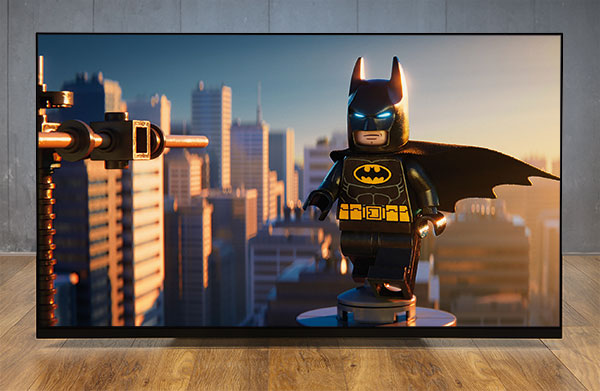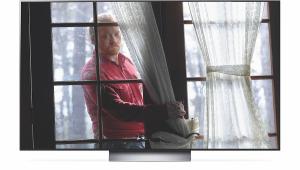LG OLED65E9PLA OLED 4K HDR TV review Page 2
DV grading always seems spot on. The Californian beach scenes in Dead to Me (Netflix, see p102) have enticing warmth, while zombie drama Black Summer (also Netflix), with its colour denuded palette and extreme detail, looks terrifyingly realistic.
Near-black shadow performance is an area where rival OLED brands are doing battle. For what it's worth, I spied no low-level 'flashing' during my audition, something noted on 2018 screens under certain conditions in areas of near black. Peering into the Gothic murk of What We Do in the Shadows (Amazon Prime) revealed nothing more than expected tonal variations. Running through the subterranean sequences in Resident Evil: The Final Chapter (UHD Blu-ray) revealed plenty of low-level noise, but this isn't particularly detectable at a normal viewing distance.
 The brand's frame interpolation toolbox is impressive. Trumotion can be switched off, or run with Smooth, Clear or User determined dejudder and deblur (my preference is for de-judder on or near zero, and de-blur close to 10; yours may vary). Clear processing does introduce minor artefacts, but for general TV content and sports (I experimented with tennis and Formula 1), it looks fine. For movie playback I would typically turn the setting off completely. The Motion Pro option is actually a Black Frame Insertion tweak, albeit one that introduces flicker and stutter.
The brand's frame interpolation toolbox is impressive. Trumotion can be switched off, or run with Smooth, Clear or User determined dejudder and deblur (my preference is for de-judder on or near zero, and de-blur close to 10; yours may vary). Clear processing does introduce minor artefacts, but for general TV content and sports (I experimented with tennis and Formula 1), it looks fine. For movie playback I would typically turn the setting off completely. The Motion Pro option is actually a Black Frame Insertion tweak, albeit one that introduces flicker and stutter.
Deeper control can be had through Dynamic Contrast, Dynamic Colour, Super Resolution, and Dynamic Tone Mapping tools. The latter has been given an overhaul this season, with improved signal range detection algorithms. Tone mapping is also now optimised for panel type.
Of course, not everything you'll watch is in HDR, and some questions remain over the E9's treatment of SDR. Doing time with Orange is the New Black (Netflix), the image looks over-egged when HDR Effect is engaged. It's certainly not as satisfying, or convincing, as Sony's Object Based HDR Remastering default setting.
Assured Audio
The E9 impresses sonically. The TV may flaunt a wafer-thin design, but makes a fine noise, even if the sound output – designated as 4.2-channel – still sounds basically stereophonic. Dialogue is crisp and clear, with appreciable mid-range. When Supreme Leader Snoke makes his displeasure felt at the downing of the Dreadnought, in ...The Last Jedi, there's reassuring rumble and menace to his voice.
Dolby Atmos decoding is onboard (as well as processing to upmix stereo sources to virtual surround), but obviously the TV can't do that much with the immersive audio format. You'll want to export an Atmos bitstream to a soundbar or AV system. Still, as far as integrated audio systems go, this is one of the better factory options.
New this year is support for the WiSA wireless audio standard. Speakers connected via WiSA rather than Bluetooth, as used by LG in 2018, offer better latency performance and have support for 5.1 multichannel connections. Unfortunately I couldn't actually test this, as no WiSA-compatible speakers were supplied.

Gaming performance is excellent, provided you utilise the Game preset, where measured input lag is just 12.8ms. And console junkies will appreciate the inclusion of Auto Low Latency Mode and Variable Refresh Rate from those HDMI 2.1 ports. Enabled by the in-menu Fast Game Response setting, the TV should auto switch to a Game mode when receiving an ALLM signal.
Ready For Battle
There remain some quirks (I'm not a fan of HDR Effect), but generally speaking the E9 is a fabulous performer, with a host of cutting-edge features. There's actually scant difference across the various LG OLEDs. Points of difference are largely cosmetic and reflect the various sound solutions offered. Here the overall design of the set is a real crowd-pleaser, and its onboard audio is often bafflingly good.
Of course, the elephant in the room is HDR10+, the rival dynamic metadata standard to Dolby Vision. It's not clear if this will gain significant traction, although the system is widely used by Amazon Prime Video, and is finding its way onto Blu-ray discs. Its absence here puts the E9 at a tick-box disadvantage if you want your next TV to be as future-proof as possible. It also leaves LG vulnerable to incoming OLED models from Philips and Panasonic that support HDR10+ and Dolby Vision. Yes, the E9 is good, but we won't know just how good until the latest Philips and Panasonic sets hit the HCC test bench.
HCC Verdict
LG OLED65E9PLA
Price: £3,500
www.lg.com/uk
We say: First-class picture performance makes this a cinematic treat, and functionality is leading edge. But how significant is the lack of HDR10+?
Performance: 5/5
Features: 4.5/5
Design: 5/5
Overall: 5/5
Specification
3D: No
4K: Yes. 3,840 x 2,160
HDR: Yes. HDR10; HLG; Dolby Vision; Technicolor
Tuner: Yes. Freeview Play; satellite HD
Connections: 4 x HDMI inputs; 3 x USB; Ethernet; digital optical audio output; headphone output
Sound (claimed): 60W Brightness (claimed): N/A
Contrast Ratio (claimed): N/A
Dimensions (off stand): 1,447(w) x 877(h) x 50.3(d)mm
Weight (off stand): 20.8kg
Features: Built-in Wi-Fi; WiSA wireless connectivity; Bluetooth; USB multimedia playback; second-generation Alpha9 processing engine; WebOS with ThinQ AI; voice control; Google Assistant built-in; Amazon Alexa; Apple Airplay 2; HDMI 2.1 specification (includes eARC, VRR, HFR)
 |
Home Cinema Choice #351 is on sale now, featuring: Samsung S95D flagship OLED TV; Ascendo loudspeakers; Pioneer VSA-LX805 AV receiver; UST projector roundup; 2024’s summer movies; Conan 4K; and more
|

















































